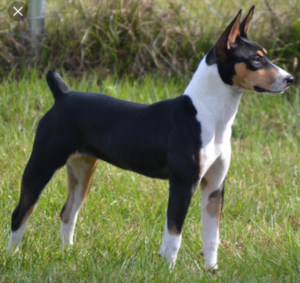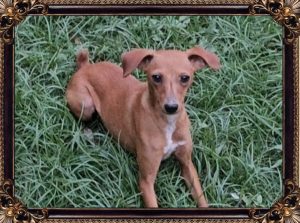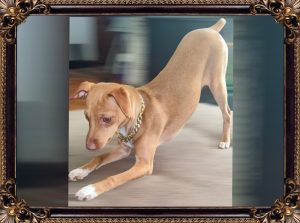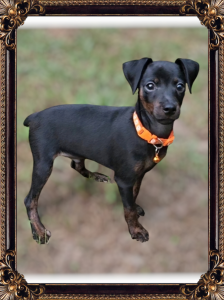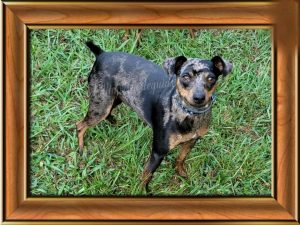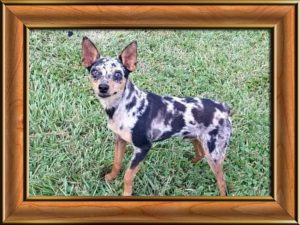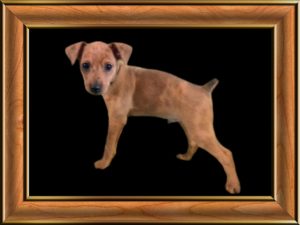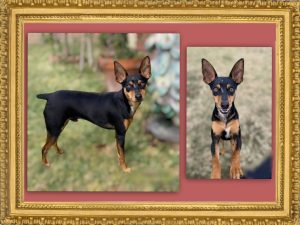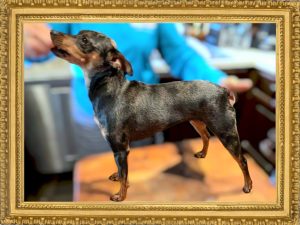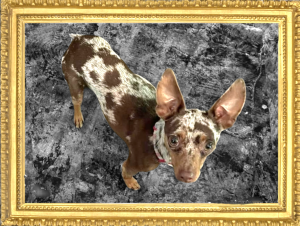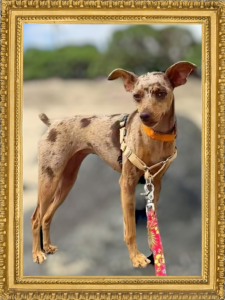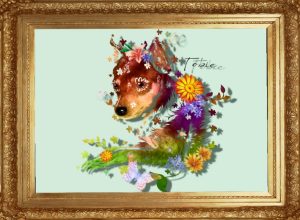
To understand color coat genetics, its best to start from the beginning and know what it first.
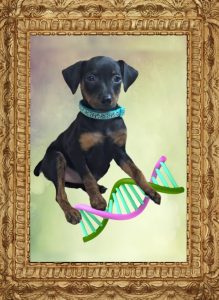
Black and Tan Brindle
It all starts with a tiny microscopic molecule called DNA. DNA is found in every cell within a living organism and contains the instruction manual for the organism’s development and function. DNA is also known as the genetic code (sequence) and is unique to every living organism. A DNA molecule is made up of an abundance of genes and each have their own fixed position (known as the locus) within the DNA strand. Genes are inherited, meaning they passes from parents to offspring. Offspring receive one copy of a gene from each parent. Some are dominant and some are recessive.
Genes determine specific characteristics of an organism known as traits. this includes the color, size, shape, temperament and a host of other characteristics that an organism possess. Some we can see and many that we can not.
In short, your dog’s DNA determines their coat color. The part of the DNA sequence that is primarily responsible for coat color is known as the melanocortin 1 receptor (MC1R) gene. This gene is located on the surface of melanocytes cells which surround each hair follicle. The MC1R gene provides the instructions for which type of color the melanocytes produce. There are ONLY 2 choices. Ether its eumelanin (black) or phaeomelanin (red/yellow).

Brown and Tan
Genes and alleles are represented in genetic test results using the alphabet. Uppercase letters representing dominant genes and lowercase letters representing the recessive genes and alleles.
For example:
B- Dominant, b-Recessive, K^br-Dominant with a alleles attached, a^y-Recessive with a alleles attached.
ALLELES
Their are many variations of genes that also influence the exact color that a dogs coat is gonna be. These variations are known as alleles and depending on their mode of inheritance, they can influence a dogs coat color in a number of ways. Some are dominant and some are recessive.
**A gene or allele of a gene is said to be dominant when it effectively expresses itself more strongly than other genes or alleles. Only one copy of the gene or allele is needed to be expressed.
**A gene or allele of a gene is said to be recessive when 2 copies of the gene or allele is needed to effectively express itself.
**Incomplete Dominance (semi-doninance). This phenomenon is a form of gene interaction (blending) in which both alleles of a gene are neither completely dominant over the other and are partially expressed. Often resulting in a partially expressed or different phenotype of either parent. This phenomenon occurs with mostly recessive genes.
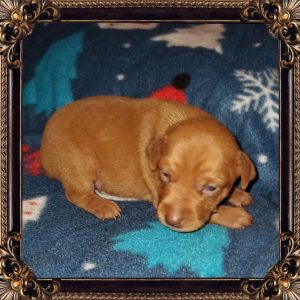
Red with Brown Nose
For example:
A dominant stag red dog (a^y/a^y, ) that does not carry for brown (B/B) is bred to a brown dog (b/b). The resulting offspring could be Stag Red, Red, Black, brown stag red (intermingling brown hairs instead of black), Red with brown/nose.
The brown stag red and the red with brown nose offspring displays this incomplete dominance phenomenon with the expression of the brown gene(b). As ALL offspring are genetically (B/b) which means they should be black based.
Another example of incomplete dominance is the merle gene. Though the potential offspring receives the full copy of the merle gene. It is considered incomplete as NO 2 merle patterns are exactly the same. 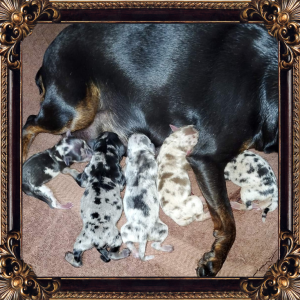
COLOR GENES
There are 5 different genes that can influence a dogs coat color. Also, within these genes are alleles that can variate the expression of each gene.
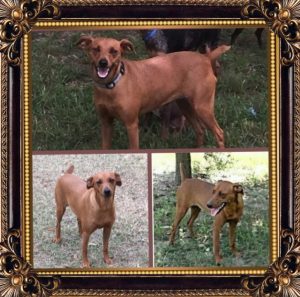
Clear Red
THE AGOUTI GENE (A-LOCUS):
The Agouti gene is also known as the A-locus and is responsible for a variety of coat colors. It is represented by the letter A. Recessive in nature but also can be imcomplete dominant depending on other gene factors. It encodes the agouti signaling protein (ASIP) gene. This gene acts as a molecular switch that interacts with the MC1R gene to control eumelanin (black) and phaeomelanin (red) pigment in a dogs hair cell. The ASIP gene governs four different alleles. These are ay = Fawn/sable, aw = Wild sable, t = Black-and-tan, and a = Recessive black. These four alleles work in a hierarchy and ay is the most dominant of them all.
EXTENSION GENE (E-LOCUS):
The Extension gene is also known as the E-locus and is responsible for the expression of the black pigment (eumelanin). The E-locus is dominant in nature as it only takes one copy of the gene to be expressed. It is governed by the MC1R gene. It has three possible forms: black (E/E), black/carrier of recessive black (E/e), recessive red (e/e)- will stop all production of eumelanin and express only yellow/red. Dogs that are “e/e” are also known as clear reds. There are several alleles of the E-locus but only one that is known to the Miniature Pinscher and Harlequin Pinscher. This is the melenistic mask (E^m). This allele is responsible for the black mask in Stag Reds and the darkening of the tan points in the Black/Tan and Brown/Tan dogs. It is a unwanted gene in the breeds and caution should be taken if a dog carries for this gene. It can somewhat express itself with only one copy but a dog that carries 2 copies of the alleles could be nearly solid black!
**The recessive red gene (e/e) can hide the merle and brindle patterns. Caution must be taken if a recessive red dog is kept in a breeding program. Genetic testing to know if the dog is genetically a merle is a must in the Harlequin Pinscher breeding program.
DOMINANT BLACK GENE (K-LOCUS):
The Dominant Black gene is also known as the K-locus. The K-locus is a dominant gene and the control tower between the production of eumelanin (black) and phaeomelanin (red) pigments. It has 3 alleles. Dominant black (KB or K^B)-this will block the A-locus expression and inhibit the MC1R gene to product eumelanin. Recessive form (ky or k^y)- this will allow the production of phaeomelanin from the A-locus. The 3rd is a mysterious form as not much is known about it. The “brindling” allele (Kbr or K^br). This allele will allow the expression of the A-locus to come through but causes brindling of the agouti patterns. Kinda a “glitch” in the system to sorta speak. We do know that it is recessive in nature and strangely as far as we have seen in the Harlequin Pinscher it CAN NOT be carried and only requires one copy of the allele to be express.
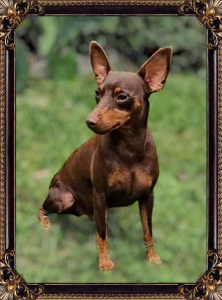
Brown and Tan “Chocolate”
BROWN GENE B-LOCUS:
The Brown gene is also known as the B-locus or TYRP1 gene and is responsible for the brown and liver colored coats. This gene is a modifying gene and affects eumelanin (black pigment). The gene produces a protein that modifies eumelanin by disrupting its synthesis. Their are different alleles of this gene but their exact function is not 100% known at this time. It is speculated that the different alleles are responsible for the variation in the intensity that the brown gene expressing in a dog coat. Form Dark Brown (nearly black) to a light caramel (Liver) shade. In all, a dog must have 2 copies of the gene to be brown, regardless of the alleles present. The B-locus gene itself is recessive in nature with (“b”) representing its form. A dog with the genotype of B/B would be a black dog, the genotype B/b would be a black dog that carries brown and a dog with the genotype (b/b) would be a brown dog. The brown gene will also cause a dogs eye color to become greenish gold-gold colored and their nose pads, eye rims and paw pads to become pinkish to light brown in color.
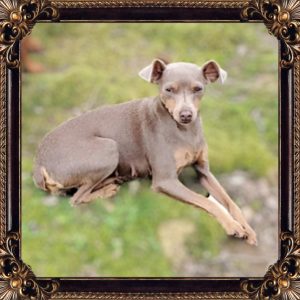
Fawn and Tan
DILUTE GENE D-LOCUS:
The Dilute gene is also known as the D-locus or MLPH gene and is responsible for lightening of a dogs coat. The dilute gene is not a color gene though it is located on the color gene loci within the DNA strand. It is a type of mutation gene, is recessive in nature and affects both eumelanin) and phaeomelanin (red) pigments. Resulting in lighter “diluted” coat color that can appear gray (blue) in black dogs, silver (fawn) in brown dogs or Tan (Cream) in Red dogs. It is recessive in nature with (“d”) representing its form. A dog with the genotype D/D would not be a dilute, the genotype D/d would not be a dilute but would carry dilute and a dog with the genotype d/d would be a dilute dog. Their exact color would also depend on their genotype at the A,B, E and K locus. The dilute gene will also lighten a dogs eye color, nose pads, eye rims and paw pads.
The dilute gene is a mutating gene and it affects the distribution of pigment in the hair shaft, causing the color pigments to CLUMP together which gives the illusion of a lighter colored coat. Unfortunately, this can cause the hair shafts to become brittle and break. This is the reason that some dilute dogs have shorter hairs in their coats than the non dilute colored dogs and consequently this mechanism could lead to color dilute alopecia (CDA).
Dilute colored dogs do require more maintenance as coat health is very important. NOT ALL DILUTE COLORED DOGS ARE AFFECTED WITH CDA. Its a luck of the draw but with carreful breeding practices and education, the chances of a dog being affected with CDA is 1 in 100.
PATTERN GENES
M (MERLE) LOCUS:
Merle is a very genetically fascinating gene and a beautiful coat pattern that has been around for centuries. It likely has been a apart of all breeds of dogs at one point in time but like many other things, once people with a high ranking dislikes something it gets extinguished.
The merle gene is also known as the M-Locus gene or the SILV gene with a SINE element insertion that causes the merle phenotype. It is NOT a color gene itself. It is located on a different loci than the color genes and is a pattern gene. It is responsible for modifying (diluting) irregularly shaped patches of a dogs coat to a lighter color shade. It only affects the eumelanin (black) pigment. It can be especially visible in black, brown, blue, or fawn colored dogs. The merle pattern may be seen in Stag red, Blue Fawn or Chocolate Stag Red dogs at birth usually fades as the dog gets older depending on the intensity of the eumelanin expression in the coat. Recessive red (e/e) merle dogs WILL NOT EXPRESS THE MERLE GENE. It will be hidden.
*Red dogs should not be used in a merle breeding program. Extreme caution and responsibility should be taken if they are. They do not have as pretty of a pattern and some are very hard to detect at birth. Most of the merle pattern in red dogs fade as they get older. Leaving them just red. Some pups are born with such a light pattern that they must be DNA tested to verify their merle status.
The merle gene is incomplete dominant (semi-dominant) in nature and only one gene is needed to be expressed. EITHER A DOG IS MERLE OR ITS NOT. The merle gene CAN NOT be carried and one parent must be merle in order to produce merle offspring.
**A merle dog SHOULD NOT be paired with another merle dog. IMO it is unethical to do so as the results could be potentially producing double merle offspring. A double merle is a dog that has 2 copies of the merle gene. The merle pattern of a double merle is usually WHITE with severely jagged or torn edges around the color patches. NOT to be confused with the piebald gene! It can sometimes be hard to detect if the piebald gene is present. A double merle can be lethal in utero and double merles that are born can potentially have a host of health issues including deafness and/or blindness.
Each merle patterned coat is unique unto itself and No 2 merle dogs are exactly alike as the merle gene pattern affects random patches of a dogs coat. A merle pattern can be anything from one tiny hair to nearly the whole dog.
Many breeds today do have the merle pattern and the colors are often referred to differently depending on the breed. This is how many people get confused as to what color a merle patterned dog truly is. The merle gene is also often confused with the dilute gene as both do have similar ways of expression in a dogs coat (dilution) but they are 2 different genes and are located on different loci within the DNA strand. The merle gene works by “modifying” the amount of pigment to be produced in random patches of a dogs coat. Giving the coat a mottled, patched or splotched appearance.
*The merle gene causes color pigments to be EVENLY distributed along the hair shaft and DOES not cause the pigments to CLUMP as the dilute gene does and they CAN BE SAFELY COMBINED. This is the reason that NON DILUTE merle patterned dogs DO NOT have coat issues unless other genes or environmental factors are involved. In my experience with the 2 genes so far, I have never seen the merle pattern itself affected by the dilute gene (CDA).
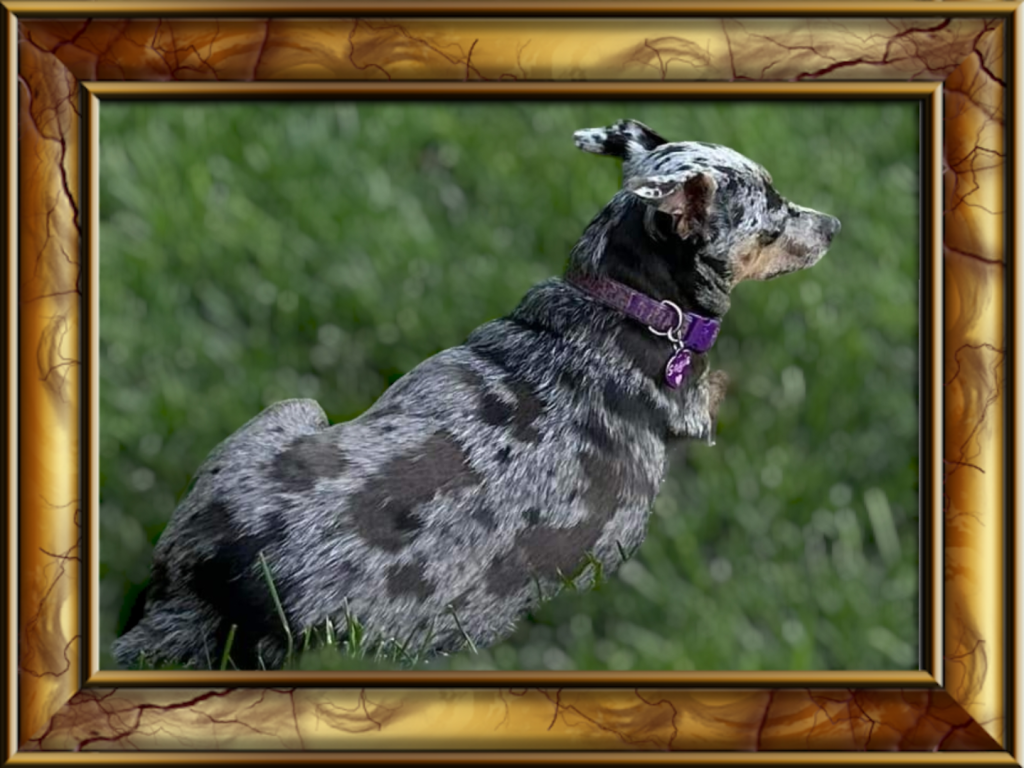
Blue and Tan Merle with a form of Alopecia
I have only seen 2 dilute merle dogs with a form of Alopecia in the 10 years that I have been with the Harlequin Pinscher breed. Both were Blue/Tan merles and the Alopecia affected the dogs diluted blue/gray patches and NOT the merle pattern. If you look closely to the Blue and Tan Merle dog above, you can see that the hairs in the dark blue/gray patches are shorter and they appear “fuzzy”. The lighter and longer blue/gray areas is the merle pattern. Now whether this was a case of genetic alopecia or acquired alopecia, I do not know. I do know that the lineages of this dog and the other merle dog with alopecia were dismissed from the Harlequin Pinscher breeding program.
The merle gene DOES NOT change a dogs DNA genotype. A merle dogs coat color is determined by the genetic color of the larger (more pronounced) and darker splotches or patches of hair within the coat. THE LIGHTER COLOR IN A MERLE DOGS COAT IS THE MERLE PATTERN. A genetic tested black/tan merle will have BLACK splotches or patches with the lighter (modified) merle pattern. It will only genetic test as a black/tan. Some breed fanciers call a black/tan merle a blue merle as the pattern appears to be gray (blue) toned. This is genetically not correct and very misleading to uninformed puppy buyers as the dog is only expressing the color black and the merle gene. Many end up paying for this deception, thinking they are getting a genetically blue merle when in fact it is not.
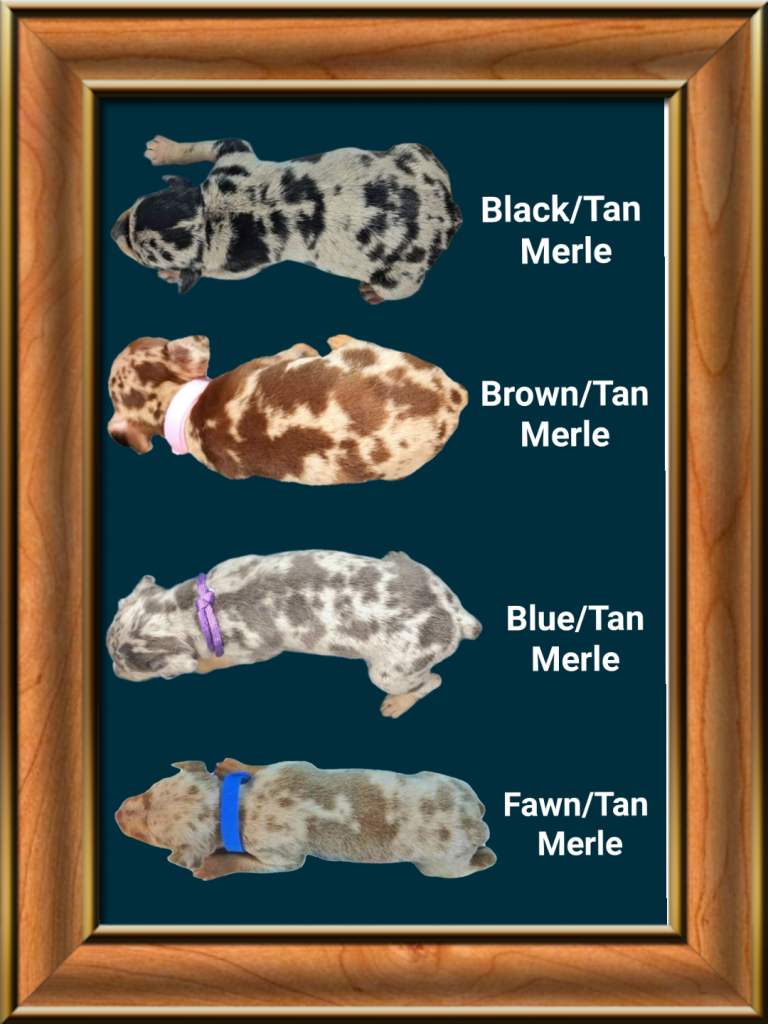 Black/Tan merle = Black splotches or patches
Black/Tan merle = Black splotches or patches
Brown/Tan merle = Brown splotches or patches
Blue/Tan Merle =Blue splotches
Fawn/Tan merle = Fawn splotches or patches
The merle gene has its own modifiers which can cause the pattern to have different expressions. These modifiers are known as alleles or phases and are locate within the SINE element of the SILV gene. The merle pattern can be expressed anywhere from a light silvery colored (nearly white) to a dark steel gray (nearly black) in the genetically black/tan or blue/tan dog and can be expressed anywhere from a light ivory to a dark mocha color in the genetically brown/tan dog.
Which phase of merle a dog expresses is determined by the length of the polyA tail of the SINE element- also known as insertions. This is reason that the merle gene is a incomplete or semi-dominant gene. Currently there are 6 known phases (alleles) of the SINE element but there could be more!
There are genetic test available to determine what length of merle a dog has. The existing merle phases (alleles) know at this time are Mc, Mc+, Ma, M, and Mh. With Mc (cryptic merle) being the shortest form of the polyA tail and expressing the darkest pattern (visually none to very little) to the Mh (harlequin merle) being the longest form of the polyA tail and expressing the nearly white pattern. Mh IS NOT THE SAME GENE AS THE HARLEQUIN GENE (H) found in the Great Dane.
**The Mh alleles can cause more pigment impairment health concerns than the other merle alleles. Though breeders of other breeds strive to produce this phase of merle, it is IMO unethical to do so because the only way to achieve this phase is by pairing 2 merle dogs.
Basically the longer the polyA tail insertion, the greater the effect on the dog’s coat. There is a scale chart that was developed by a group of Catahoula dog breeders along with a genetic lab in the Czech Republic to map these phases and help other merle breeders understand the polyA tail insertion. Its known as the merle scale and shows the different phases in both numerical and alphabetical codes.
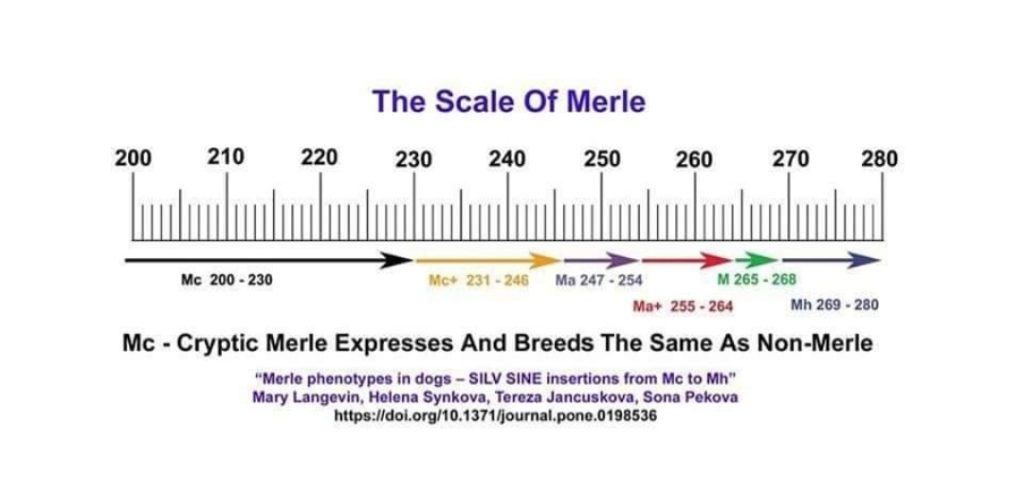
Though most all of the merle patterned Harlequin Pinscher genetic test to be (M) 265-268. Its pretty interesting to know that there are more possibilities out there.
If you are really interested to know more about the merle gene and the different phases of merle. Here is a great article to read:
www.merle-sine-insertion-from-mc-mh.com/storyofmerle/
HARLEQUIN GENE (H-LOCUS):
I won’t go into much detail about this gene as it is NOT a part of the Harlequin Pinscher breed but it is a type of modifying gene. The harlequin gene occurs on the H Locus and is exclusively within the Great Dane breed. When inherited alongside another gene, it affects the way that the gene appears. If a dog inherits the modifier but not the gene that it modifies, there is no obvious change to the gene. So, when a Great Dane inherits both the harlequin gene and the merle gene, the areas between their dark patches become pure white. Sometimes, gray ticking or patches will develop, too. This means that a blue (black) merle becomes white with black patches, as the gray in its coat turns to white.
The modifier also affects phaeomelanin (red), so even if a dog is sable, their coat will become “fawnequin” with tan and black patches on a white base. Unfortunately, the harlequin gene may be a dominant embryonic lethal gene. This means that all “H/H” puppies die before birth, leaving only “H/h” puppies to be born. IMO totally UNETHICAL, and that is all I have to say about that!
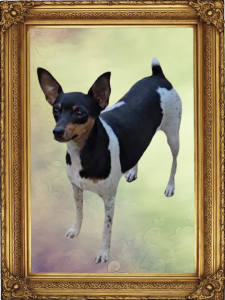
Black and Tan Piebald
SPOTTING GENE (S-LOCUS):
The spotting gene is located on the S locus and is responsible for the Tri, Tuxedo and piebald patterns in the Harlequin Pinscher. It is recessive in nature and can occur with any coat color. It works by blocking the pigment cells from producing any pigment, causing areas in the coat to be white. So far, only two alleles are known to exist on the S locus. These are S^p, which produces piebald patterns and S^w, which responsible for “extreme white”.
**Extreme piebald dogs can potentially be deaf and/or blind. Currently we have only seen very few extreme piebald dogs in the Harlequin Pinscher. This gene IS NOT 100% understood and it is in the best interest of the breed to not use any piebald dog in a Harlequin Pinscher breeding program that expresses a large amount of white on the head of the dog (little to no color).
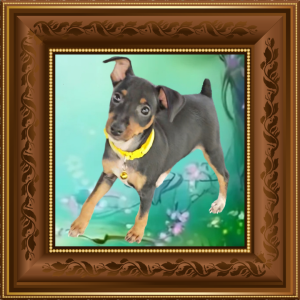
Black and Tan Tri
The TRI COLOR pattern is the lowest form of the piebald gene and it only takes 1 copy of the gene to produce. Small amounts of white is usually seen on a dogs toes, chest, chin and forehead.
**This is not to be confused with the Irish white spotting gene that sometimes cause similar markings due to an interruption of pigment migration during embryo development.
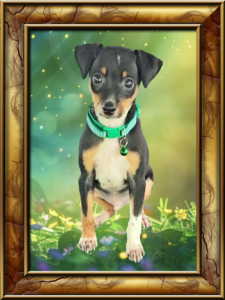
Black and Tan Tuxedo
The TUXEDO pattern is also a lower form of the piebald gene and it only takes 1 copy of the gene to produce. A tuxedo patterned dog usually had a moderate amount of white located on their toes and may extend up the forelegs, white on chest that extends to the navel area, white on throat and chin area, a white blaze on the forehead, white on muzzle and sometime a white collar around their neck. The amount of white can vary and no 2 tuxedo pups are exactly the same.
**There is a sure way to distinguish a tuxedo pattern from a tri pattern. When the dog is stood on their back feet, it should appear that they are wearing a tuxedo. I personally do not label a pup a Tuxedo pattern unless I know that genetically they do carry the piebald gene and they do have all 4 feet with white, a large amount of white that extends down their chest and white in some degree on their muzzle or head.
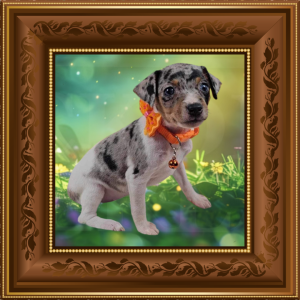
Black and Tan Merle Piebald
The PIEBALD pattern is the most sought for pattern of the S-locus. It takes 2 copies of the gene to produce piebald offspring. A piebald is a colored dog with unpigmented white patches in various part of the coat. The extent and position of the pattern can vary from dog to dog and range from one small spot (extreme piebald) to all over the body.
**The piebald pattern is very distinct with the color patches having nicely smooth edges. They are not jagged or torn like the double merle patches. SURE WAY TO TELL IF A PUP IS A TRUE PIEBALD OR A DOUBLE MERLE!!!
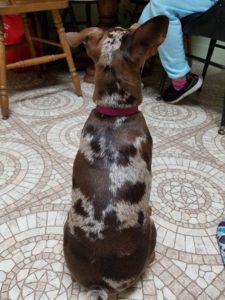
Brown and Tan Merle Tweed
